
What to eat before and after training
The food we eat has a direct influence on sports performance and subsequent recovery. What should we eat before and after each training session?
It is difficult to clearly summarise the factors that happen in our body when we carry out a sport. The type of training, the time we devote to it, even our routine and the diet that we usually eat are crucial elements for defining which foodstuffs to add to the shopping list to achieve our top performance from training sessions.
“We must take into account that if we do high intensity exercise for long periods, gastrointestinal stress occurs, and therefore, we enter an ischemia process in which the blood concentrates in the muscles, making the digestion and absorption process difficult,” the food technologist and sports nutritionist from FC Barcelona and from ASSISPORT, Mireia Porta affirms, who advises letting the stomach rest for a minimum of 2-3 hours between a meal and a training session.
Once the session has finished, the body’s metabolisation process, known as the “metabolic window” must be taken into account. This term refers to the 30-45 minutes after carrying out exercise, the optimum moment for the organism to refill its deposits of muscular glycogen through nutrients such as antioxidants, carbohydrates and proteins to start an effective regeneration process. But, what happens depending on the type of training we carry out?
Water every 20 minutes
Porta is clear: “If we have a different training programme, our nutritional needs will also be different. For a cardiovascular based exercise or a long-lasting session, we need more energy intake for our body to respond, therefore, we will look for muscular glycogen (through easily-digested carbohydrates and proteins). On the other hand, if we are doing strength training, we will need greater nutritional intake and amino acids to restructure the muscles (through a greater protein intake.)”.
The first factor involved in a drop in performance is dehydration. Water, therefore, is an essential food that must be included in training sessions approximately every 20 minutes, always taking into account factors such as the type of training session, each individual’s physical condition and the room temperature.
To know whether we are well hydrated, Porta explains that “we should not lose more than 2% of our body weight during the exercise,” and she recommends including a pre-hydration process drinking water, broths or teas before exercising and including liquids, such as protein shakes, in the post-hydration process after training to ensure there is no imbalance in the level of minerals and potassium in the body.
When and what should we eat?
If we talk about key foods to eat before a training session, allies might be a rice flapjack, a non-protein cereal bar or a piece of fruit, foods that are a source of easily-digested carbohydrates and that can provide the energy needed during the exercise.
Once the training session has finished, some of the foods that we can include are those that give us carbohydrate and protein in a balanced way, such as a yogurt with a banana, an almond milkshake with protein powder or an oat-based bowl; always taking advantage of the fact that the body has a greater recovery capacity in this first phase.
“There are some foods, such as those that have a high fibre or acid content and of course, fried food and fats, which will make a training session much more difficult, particularly due to the digestion time that they entail,” Mireia Porta indicates, who also urges avoiding alcohol specifically after exercising.
Nutritious supplements
Finally, sports supplements can also help to achieve the maximum performance and to avoid deficits. Nutrients such as vitamin D, Omega 3, vitamin B12 or iron need to reach optimum values if we exercise regularly, therefore a supplement of this type could be a good ally.
Furthermore, there are ergogenic aids, such as milk or vegetable whey, which help in the recovery and muscular anabolism process, or creatine, which reduces the damage caused to the muscles during exercise. Sporting gels, compotes or fruit gums that provide macronutrients such as carbohydrates and proteins also are a good option for the process of re-establishing the amino acid and muscular structure and therefore, achieving a better recovery.




